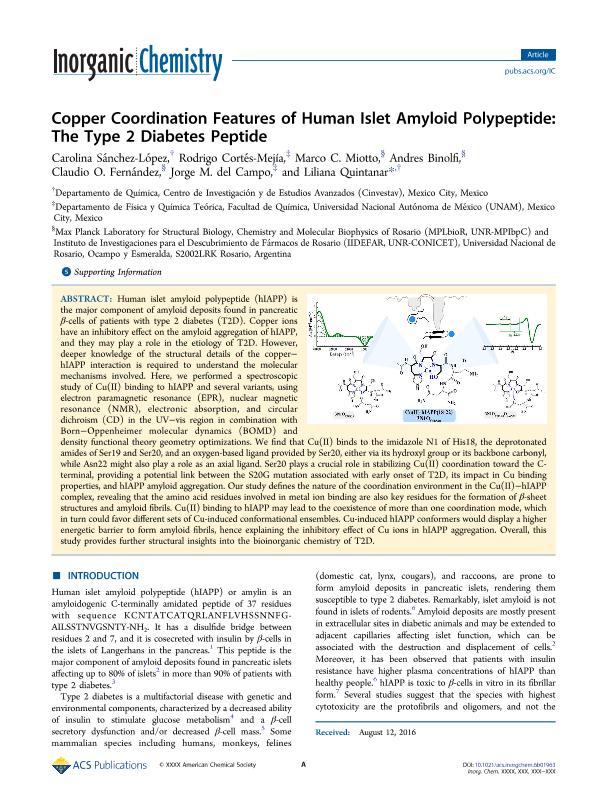Mostrar el registro sencillo del ítem
dc.contributor.author
Sánchez López, Carolina
dc.contributor.author
Cortés Mejía, Rodrigo
dc.contributor.author
Miotto, Marco César

dc.contributor.author
Binolfi, Andrés

dc.contributor.author
Fernandez, Claudio Oscar

dc.contributor.author
Del Campo, Jorge M.
dc.contributor.author
Quintanar, Liliana

dc.date.available
2018-07-19T19:51:12Z
dc.date.issued
2016-10
dc.identifier.citation
Sánchez López, Carolina; Cortés Mejía, Rodrigo; Miotto, Marco César; Binolfi, Andrés; Fernandez, Claudio Oscar; et al.; Copper Coordination Features of Human Islet Amyloid Polypeptide: The Type 2 Diabetes Peptide; American Chemical Society; Inorganic Chemistry; 55; 20; 10-2016; 10727-10740
dc.identifier.issn
0020-1669
dc.identifier.uri
http://hdl.handle.net/11336/52702
dc.description.abstract
Human islet amyloid polypeptide (hIAPP) is the major component of amyloid deposits found in pancreatic β-cells of patients with type 2 diabetes (T2D). Copper ions have an inhibitory effect on the amyloid aggregation of hIAPP, and they may play a role in the etiology of T2D. However, deeper knowledge of the structural details of the copper-hIAPP interaction is required to understand the molecular mechanisms involved. Here, we performed a spectroscopic study of Cu(II) binding to hIAPP and several variants, using electron paramagnetic resonance (EPR), nuclear magnetic resonance (NMR), electronic absorption, and circular dichroism (CD) in the UV-vis region in combination with Born-Oppenheimer molecular dynamics (BOMD) and density functional theory geometry optimizations. We find that Cu(II) binds to the imidazole N1 of His18, the deprotonated amides of Ser19 and Ser20, and an oxygen-based ligand provided by Ser20, either via its hydroxyl group or its backbone carbonyl, while Asn22 might also play a role as an axial ligand. Ser20 plays a crucial role in stabilizing Cu(II) coordination toward the C-terminal, providing a potential link between the S20G mutation associated with early onset of T2D, its impact in Cu binding properties, and hIAPP amyloid aggregation. Our study defines the nature of the coordination environment in the Cu(II)-hIAPP complex, revealing that the amino acid residues involved in metal ion binding are also key residues for the formation of β-sheet structures and amyloid fibrils. Cu(II) binding to hIAPP may lead to the coexistence of more than one coordination mode, which in turn could favor different sets of Cu-induced conformational ensembles. Cu-induced hIAPP conformers would display a higher energetic barrier to form amyloid fibrils, hence explaining the inhibitory effect of Cu ions in hIAPP aggregation. Overall, this study provides further structural insights into the bioinorganic chemistry of T2D.
dc.format
application/pdf
dc.language.iso
eng
dc.publisher
American Chemical Society

dc.rights
info:eu-repo/semantics/openAccess
dc.rights.uri
https://creativecommons.org/licenses/by-nc-sa/2.5/ar/
dc.subject
Copper
dc.subject
Diabetes
dc.subject
Bioinorganic
dc.subject
Biophysics
dc.subject.classification
Otras Ciencias Químicas

dc.subject.classification
Ciencias Químicas

dc.subject.classification
CIENCIAS NATURALES Y EXACTAS

dc.title
Copper Coordination Features of Human Islet Amyloid Polypeptide: The Type 2 Diabetes Peptide
dc.type
info:eu-repo/semantics/article
dc.type
info:ar-repo/semantics/artículo
dc.type
info:eu-repo/semantics/publishedVersion
dc.date.updated
2018-07-18T20:49:16Z
dc.journal.volume
55
dc.journal.number
20
dc.journal.pagination
10727-10740
dc.journal.pais
Estados Unidos

dc.journal.ciudad
Washington
dc.description.fil
Fil: Sánchez López, Carolina. Centro de Investigación y de Estudios Avanzados. Departamento de Química; México
dc.description.fil
Fil: Cortés Mejía, Rodrigo. Universidad Nacional Autónoma de México; México
dc.description.fil
Fil: Miotto, Marco César. Consejo Nacional de Investigaciones Científicas y Técnicas. Centro Científico Tecnológico Conicet - Rosario. Instituto de Investigaciones para el Descubrimiento de Fármacos de Rosario. Universidad Nacional de Rosario. Instituto de Investigaciones para el Descubrimiento de Fármacos de Rosario; Argentina. Max Planck Laboratory for Structural Biology; Argentina
dc.description.fil
Fil: Binolfi, Andrés. Consejo Nacional de Investigaciones Científicas y Técnicas. Centro Científico Tecnológico Conicet - Rosario. Instituto de Investigaciones para el Descubrimiento de Fármacos de Rosario. Universidad Nacional de Rosario. Instituto de Investigaciones para el Descubrimiento de Fármacos de Rosario; Argentina. Max Planck Laboratory for Structural Biology; Argentina
dc.description.fil
Fil: Fernandez, Claudio Oscar. Consejo Nacional de Investigaciones Científicas y Técnicas. Centro Científico Tecnológico Conicet - Rosario. Instituto de Investigaciones para el Descubrimiento de Fármacos de Rosario. Universidad Nacional de Rosario. Instituto de Investigaciones para el Descubrimiento de Fármacos de Rosario; Argentina. Max Planck Laboratory for Structural Biology; Argentina
dc.description.fil
Fil: Del Campo, Jorge M.. Universidad Nacional Autónoma de México; México
dc.description.fil
Fil: Quintanar, Liliana. Centro de Investigación y de Estudios Avanzados. Departamento de Química; México
dc.journal.title
Inorganic Chemistry

dc.relation.alternativeid
info:eu-repo/semantics/altIdentifier/doi/https://dx.doi.org/10.1021/acs.inorgchem.6b01963
dc.relation.alternativeid
info:eu-repo/semantics/altIdentifier/url/https://pubs.acs.org/doi/10.1021/acs.inorgchem.6b01963
Archivos asociados
